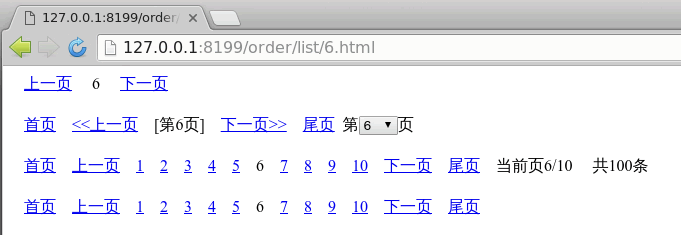Static paging refers to the use of route parameters for page pagination, where the paging object is highly coupled with the route definition of the Server. The route definition requires a route parameter with the name page, which can use fuzzy matching route *page, named matching route :page, or field matching route {page}.
Example 1, Using Fuzzy Matching Route
package main
import (
"github.com/gogf/gf/v2/frame/g"
"github.com/gogf/gf/v2/net/ghttp"
"github.com/gogf/gf/v2/os/gview"
)
func main() {
s := g.Server()
s.BindHandler("/page/static/*page", func(r *ghttp.Request) {
page := r.GetPage(100, 10)
buffer, _ := gview.ParseContent(`
<html>
<head>
<style>
a,span {padding:8px; font-size:16px;}
div{margin:5px 5px 20px 5px}
</style>
</head>
<body>
<div>{{.page1}}</div>
<div>{{.page2}}</div>
<div>{{.page3}}</div>
<div>{{.page4}}</div>
</body>
</html>
`, g.Map{
"page1": page.GetContent(1),
"page2": page.GetContent(2),
"page3": page.GetContent(3),
"page4": page.GetContent(4),
})
r.Response.Write(buffer)
})
s.SetPort(8199)
s.Run()
}
After execution, we manually visit the page http://127.0.0.1:8199/page/static/6, and the result is as follows:
Example 2, Using Field Matching Route
package main
import (
"github.com/gogf/gf/v2/frame/g"
"github.com/gogf/gf/v2/net/ghttp"
"github.com/gogf/gf/v2/os/gview"
)
func main() {
s := g.Server()
s.BindHandler("/:obj/*action/{page}.html", func(r *ghttp.Request) {
page := r.GetPage(100, 10)
buffer, _ := gview.ParseContent(`
<html>
<head>
<style>
a,span {padding:8px; font-size:16px;}
div{margin:5px 5px 20px 5px}
</style>
</head>
<body>
<div>{{.page1}}</div>
<div>{{.page2}}</div>
<div>{{.page3}}</div>
<div>{{.page4}}</div>
</body>
</html>
`, g.Map{
"page1": page.GetContent(1),
"page2": page.GetContent(2),
"page3": page.GetContent(3),
"page4": page.GetContent(4),
})
r.Response.Write(buffer)
})
s.SetPort(8199)
s.Run()
}
The routing rule in this example is more flexible, using the {page} field matching rule to obtain current page number information. After execution, we visit any URL according to the routing rule, such as: http://127.0.0.1:8199/order/list/6.html, and the result is as shown below:
